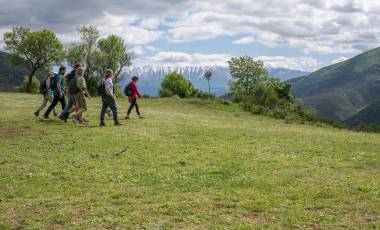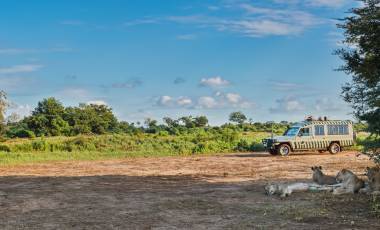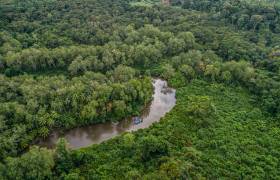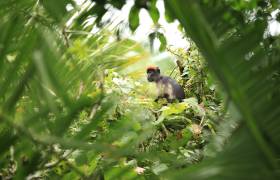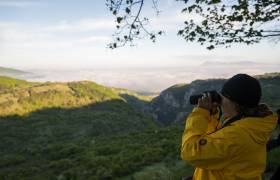We believe travel should not only immerse you in the world’s most spectacular places but help protect them too.
From the savannahs of Kenya to the rainforests of Costa Rica and Vietnam, we now have a truly global presence in species protection. In partnership with conservation experts and local communities, our projects span five key regions: Kenya, India, Italy, Vietnam, and Costa Rica, and safeguard everything from elephants and tigers to rare primates and keystone prey.
We’re Wild at Heart – and through this initiative, we’re backing bold, community-led conservation efforts to help some of the world’s most threatened species thrive.
These five projects represent a new chapter in our conservation journey – blending cutting-edge science with deep-rooted community empowerment to support the world’s most threatened wildlife.
Here’s how we’re making a difference.

Saving the World’s Rarest Primates in Vietnam through the Primate Survival Project
Vietnam is a biodiversity hotspot, home to 25 primate species, two of which rank among the world’s most endangered: the Tonkin snub-nosed monkey and the cao vit gibbon. In the northern province of Cao Bang, Exodus is proud to support Fauna & Flora’s Primate Survival Project, which uses advanced technology, such as thermal drones and acoustic monitoring, to help conservationists track elusive primates in near-inaccessible terrain.
The cao vit gibbon population has grown from just 20 in 2002 to 74 individuals today, thanks to persistent habitat protection and monitoring. The project is also building local conservation capacity – from training rangers to restoring forest corridors – while providing sustainable livelihood alternatives through ecotourism, traditional crafts, and salaried jobs.
The project also focuses on restoring the forest itself, giving these species the habitat they need to recover. Local communities are central to this mission. By creating sustainable livelihood opportunities and promoting environmental education, the project ensures conservation isn’t imposed from the outside but grows from within. It’s a pioneering model for what conservation can and should look like: technologically advanced, ecologically effective, and socially inclusive.
Find out more about our Primate Survival Project here.

Rebalancing the Rainforest in Costa Rica through the Jaguar Resilience Project
On the Osa Peninsula in Costa Rica, a fascinating ecological experiment is underway. The white-lipped peccary, a keystone species and critical prey for jaguars, has disappeared from large parts of its former range, unsettling predator-prey dynamics and weakening forest health. The Jaguar Resilience Project, a Wild at Heart initiative led by Osa Conservation and supported by Exodus, is working to bring the peccary back.
This ambitious reintroduction effort aims to release healthy peccary groups into the wild, restoring balance to one of the most biodiverse ecosystems on Earth. But it’s more than just rewilding – it’s rooted in long-term community partnership. Local Rewilding Ambassadors are being trained to lead ecotourism and environmental education, while rangers are equipped to monitor reintroduced wildlife and protect habitats.
Over the next three years, the project will expand its reach across southern Costa Rica’s Piedras Blancas region, combining species recovery with school programmes, community workshops, and sustainable tourism models. With rigorous monitoring in place, it’s a smart and scalable way to rebuild forest integrity, support jaguar populations, and even inspire a new generation of conservation leaders in the region.
Find out more about our Jaguar Resilience Project here.

Returning 90% of Land to Nature in Kenya through the Free to Roam Project
Along the edge of Kenya’s Tsavo East National Park, people and wildlife have long competed for space, but now, this innovative approach is tipping the balance. With elephants regularly raiding crops and families struggling to grow enough food, communities needed a solution that works for both.
Working in partnership with Kenyan conservation experts Tsavo Trust and the Tofauti Foundation, the Exodus Adventure Travels Foundation has supported the Free to Roam Project since 2021.
Championing a bold concept known as the 10% Fence Plan, this innovative model encourages local farmers to cultivate just 10% of their land within a secure, solar-powered fence, supported by permaculture training, while returning the remaining 90% to nature. This creates safe passage for elephants and other wildlife to roam freely without the risk of conflict.
Built against a backdrop where nearly 90% of households in the Shirango Conservancy live in poverty and crop raids were devastating livelihoods, the project has delivered remarkable results.
To date, 23 solar-powered fences have been put up, protecting 129 acres (52ha) of farmland and benefiting 47 households. Each household now harvests an average of 450lb (205kg) of cowpeas, 300lb (135kg) of maize, and 630lb (285kg) of green grams – an increase of more than 70%, enough to sustain families for three to six months, even during drought.
Since the fences were built, there have been zero reported incidents of human–wildlife conflict, and the barriers have been 100% effective against elephants, buffalo, impalas, and carnivores.
In 2024, 18 local labourers helped build additional fencing to protect two more households. Building on that progress, 60 farmers received training in arid and semi-arid agriculture, and funded workshops on conservation and the benefits of tree planting were held in schools.
Find out more about our Free to Roam Project here.

Creating Safe Corridors for the Marsican Brown Bear with Rewilding Apennines
Italy may be one of Europe’s most beloved destinations, but its wild heart is under threat. In the Central Apennines, Exodus is partnering with Rewilding Apennines and Rewilding Europe to restore 12,355 acres (5,000ha) of wilderness, supported by our commitment to rewild 100 square metres for every passenger on every trip.
To date, efforts have helped rewild 1,282 acres (519ha) of ‘nature and carbon corridors’ and manage the 740 acre (300ha) Castel Madama Rewilding Reserve. But what does this mean for the Marsican brown bear, one of the most endangered species in Europe?
For centuries, it roamed freely through the Central Apennines, but as human activity expanded, their habitat shrank, cutting them off from the larger, safer spaces they need. Today, fewer than 60 of these bears remain in the wild, struggling to move between isolated protected areas.
A key focus of our work is creating five ecological corridors that allow these bears to reconnect with each other, expand their territory, and find the food and safety they need to thrive.
More than 30 bear-human conflict prevention measures have been installed, including 14 bear-proof bins, 15 electric fences, and 20 nest boxes in the Casone area. The project also supports ‘bear smart’ initiatives, such as orchard planting to divert bears away from villages and restoring ecosystems to act as natural carbon sinks. The team has also hosted a first meeting with 20 farmers to explore coexistence with wolves and continues monthly monitoring via camera traps.
All profits from the sale of our trip, Italian Apennines: Walks & Wildlife, directly support Rewilding Apennines’ vital efforts to restore biodiversity, meaning every journey helps safeguard this extraordinary landscape and the species that call it home.
Find out more about our Rewilding the Apennines Project here.

Protecting Bengal Tigers in Bandhavgarh through the Tiger Habitat Project
In India’s Bandhavgarh National Park, Bengal tigers have been staging a comeback in recent years – but their future still hangs in the balance. Although it’s long been a designated reserve, illegal poaching and habitat loss still threaten this iconic species. That’s where the Tiger Habitat Project comes in.
By easing pressure on surrounding forests, the project helps reduce human-wildlife conflict and secures space for tigers to thrive. One effective intervention? Swapping inefficient wood-burning stoves for clean cookstoves in 280 homes and upgrading wooden cattle sheds in 150 households. Together, these changes save around 84 tonnes of wood each year, potentially sparing over 1,300 trees in the next decade.
Other small but powerful shifts include providing 100 plastic cattle troughs (so fewer trees are cut for fodder), fencing for 10 households to protect livestock, and installing solar-powered streetlights to reduce night-time encounters with wildlife.
The project is also restoring nature from the ground up. Invasive lantana, a fast-spreading shrub that chokes native vegetation, has been cleared across 75 acres (30ha) of forest, helping native vegetation and wildlife bounce back. It’s already working. Camera traps and field reports show the return of diverse wildlife, from 13 mammal species to 92 kinds of birds, plus a colourful cast of reptiles, amphibians and insects.
This isn’t just about saving trees. It’s about creating lasting, healthy coexistence, where communities benefit and tigers remain a vital part of India’s wild heart.
Find out more about our Tiger Habitat Project here.
To read about our ongoing projects to protect species worldwide, please visit our Wild at Heart page.

